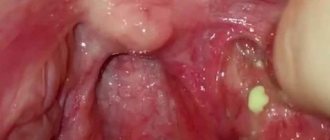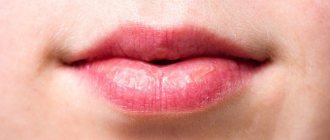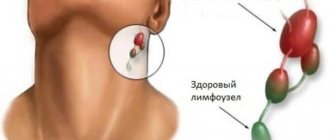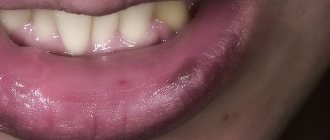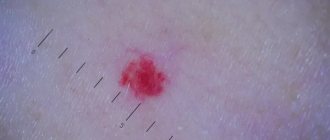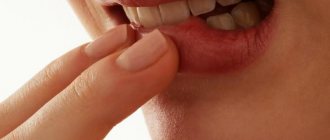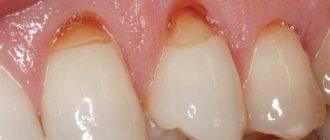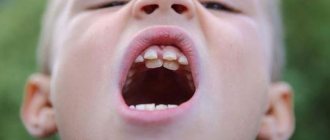Sometimes parents are faced with the phenomenon of red lips in a child. Redness of the lips in a child is a hyperemia of soft tissues, which is provoked by an intense influx of blood fluid and exposure to a certain irritant. This condition is not dangerous, but nevertheless it should not be ignored. It is necessary to consult a doctor in a timely manner, determine the provoking factor of this condition and carry out all the measures prescribed by the doctor.
Why does a child have this problem?
If a child has red lips, the causes can be caused by various factors. Redness appears on the mucous membrane, edging or the skin itself around the mouth. The reasons why a child’s lip turns scarlet may be as follows:
- development of an allergic reaction;
- weathering;
- lack of vitamin substances in the body;
- development of herpes;
- disturbances in the function of the endocrine system;
- Often the child has red lips due to the development of infectious processes or fungus;
- various diseases of the digestive system in children also provoke the appearance of a bright scarlet color;
- Lips acquire a red tint due to the development of candidiasis;
- acute respiratory viral diseases;
- the mucous membrane becomes burgundy in color with the development of acute tonsillitis or laryngitis;
- development of sinusitis;
- various skin diseases.
If scarlet lips are observed in children, you should consult a dermatologist, dentist or allergist, depending on what exactly caused this symptom.
“White” and “red” fever in children: what is it and why is it dangerous?
“White” fever is a very dangerous condition in which you urgently need to call a doctor. Anna Khoperskova, an infectious disease specialist at the Russian Railways Medicine children's clinic, spoke about the difference between “white” hyperthermia in children and the usual “red” one.
There are two conditions for fever: “white” and “red” fever.
“White” hyperthermia in children is the most dangerous. Therefore, if a child has pale, marbled skin, with a bluish tint to the nail beds and lips, the limbs are cold to the touch, the “white spot” symptom is positive when pressing on the skin, behavior is disrupted (the baby becomes indifferent, lethargic), delirium and convulsions are possible, immediately call a doctor, or better yet, an ambulance or emergency care,” the doctor recommends.
Under no circumstances should you give your child medications on your own, especially those containing acetylsalicylic acid and metamizole.
As for “red” hyperthermia, it is characterized by reddish skin - hot and moist to the touch, warm extremities, rapid pulse and breathing against a background of rising temperature. With “red” fever, the child’s behavior does not change.
“An increase in temperature or fever is a protective mechanism of the body, provided by nature as a reaction to exposure to pathogenic stimuli. During an illness, the essence of its occurrence is to increase natural protection by restructuring thermoregulation processes with the formation of higher body temperatures than in a healthy state,” explained Anna Khoperskova.
The causes of fever, in addition to a reaction to infection, can also be: overheating, metabolic or endocrine disorders, conditions after transfusion, allergic reactions, and the use of a number of drugs.
An infectious disease specialist at the Russian Railways Medicine children's clinic warned: playing games on the phone and watching TV should be avoided during treatment for “red” hyperthermia. Audio fairy tales and reading books can serve as a substitute. It is recommended to reduce the temperature using physical methods:
- undress the baby as much as possible;
- apply a cool, wet bandage to the forehead;
- regularly ventilate the room (without creating drafts);
- blow with a fan;
- wipe the body with water at room temperature;
- apply cold to the projection of large vessels (in the axillary and groin areas, on the side of the neck) and the liver area;
- to drink a lot of water.
It is recommended to take antipyretics at temperatures above 38.5 degrees. You don’t have to give medications to a child if he drinks a lot of fluids, is active, eats food as usual, has no toxicosis, and feels normal.
“It is necessary to give the child’s body the opportunity to develop that level of protective antibodies, which in the future, when encountering this infection, will help the child not get sick again or suffer from a mild form of the disease,” the doctor concluded.
Antipyretics must be given to those children who are at risk for developing complications due to high fever.
Treatment methods
If there are scarlet lips, mucous membrane or contour, treatment is prescribed depending on the specific cause that provoked the appearance of this symptom.
Pharmacy products
If the cause is an allergic reaction, it is important to avoid contact with the potential irritant. The doctor also prescribes medications - Tavegil, Suprastin, Edem, L-Cet. Such drugs have anti-inflammatory, antihistamine, antipruritic effects. In the presence of an inflammatory process or bacterial infection, doctors prescribe the following medications:
- tetracycline ointment;
- erythromycin;
- flucinar;
- sinalar.
If the provoking factor is an acute respiratory viral disease, it must be treated in a timely manner with medications prescribed by the doctor; in parallel, it is recommended to take measures to strengthen the natural resistant functions of the body. If such a symptom occurs due to the negative influence of weather factors, for example, extreme heat, wind, increased dry air, it is necessary to include in the diet foods that contain large amounts of vitamins C, B, PP, A. It is imperative to protect your skin before going outside using sunscreens with a high level of UV filter. It is recommended to choose only hypoallergenic hygienic lipsticks.
If candidiasis of the lips is diagnosed, the doctor selects appropriate medications, for example, Clotrimazole. Also, additional treatment with antiseptic agents is required, for example, Chlorhexidine, Miramistin.
If you have herpes, your doctor will prescribe antiherpetic drugs - Zovirax, Acyclovir, Gerpevir. If the disease is advanced, you will need not only external treatment, but also taking oral medications to treat herpes.
If necessary, the doctor will prescribe antibacterial agents. A course of multivitamins, immunomodulators, and, if necessary, hormonal agents and antiviral drugs is also prescribed. Timely treatment will allow you to quickly get rid of the problem.
Traditional methods
To speed up the process of regeneration and healing, you can combine traditional medicines with traditional methods. The most effective treatments for red lips are:
- a decoction based on sage and calendula: take both components in equal portions, pour boiling water over them, let it steep for half an hour, then strain, use as a lotion every half hour during the day;
- Mix freshly squeezed aloe juice with boiled oil and apply to the desired areas three times a day;
- infusion of chamomile is used for lotions;
- sea buckthorn oil;
- rosehip oil;
- tea tree oil.
It is also recommended to include an additive such as crushed egg shells in your daily diet. It needs to be washed thoroughly, dried thoroughly, and ground in a coffee grinder. Take a third of a teaspoon once a day daily. To improve blood circulation, it is recommended to perform moderate exercise and maintain a drinking regime (30 ml per 1 kg of body weight).
Journal "Child's Health" 6(9) 2007
Cheilitis (lip disease) is an inflammation of the red border, skin and mucous membrane of the lips. The clinical features of cheilitis are determined by the morphological and functional maturity of the integumentary tissues of the lips. It is customary to distinguish between independent and symptomatic cheilitis.
Independent cheilitis includes: traumatic, exfoliative, contact allergic, meteorological, glandular, microbial cheilitis. Depending on the nature of the course, acute and chronic diseases of the lips are distinguished.
Traumatic cheilitis develops as a result of damage to the lips (mechanical, chemical, thermal) and subsequent infection. The mucous membrane of the lip is clearly hyperemic, swollen, and tense. There is pain and limited mobility. Sometimes cheilitis is observed in children as a complication of mycotic, herpetic lesions. Treatment consists of prescribing antibacterial therapy: gentamicin, synthomycin, irrigation with inhalipt, as well as other antiseptic and anti-inflammatory drugs.
Exfoliative cheilitis is manifested by peeling of the red border of the lips (usually the lower) and has a chronic course. According to ICD-10, K 13.0 is classified as diseases of the lips, including exfoliative cheilitis. An important role in the occurrence of this type of cheilitis is played by incomplete, incorrect closure of the lips, hypovitaminosis of ascorbic or nicotinic acids, B vitamins, dysfunction of the central nervous system, and the thyroid gland. Exfoliative cheilitis has dry and exudative forms. In the dry form, gray or grayish-brown scales appear on the red border. The scales fall off easily, the adjacent mucous membranes are not damaged. Children complain of dry lips and the appearance of scales. The exudative form is manifested by the appearance of grayish-yellow or yellowish-brown crusts on the red border, sometimes large in size and hanging from the lip when rejected. After removing the crusts, a bright red, smooth surface is visible, there are no erosions. Patients are concerned about a burning sensation, soreness, tension in the lips, and their swelling.
Treatment consists of maintaining nasal breathing and restoring full, correct closure of the lips. Local applications of natural oils and vitamin-containing substances are prescribed: carotoline, rosehip oil, retinol, carophylene ointment. Creams are widely used: “Calendula”, “Spermaceti”. The presence of an exudative form determines the prescription of boric or boron-vaseline ointment.
Contact allergic cheilitis is more common in children over 7 years of age and is a reflection of a delayed-type allergic reaction. The reason for it is the contact of the mucous membrane of the lips with various chemicals (the habit of holding various objects in the mouth, sometimes a reaction to certain elixirs, toothpaste). Clinically, erythema forms on the mucous membrane and peeling begins.
In some cases, against the background of inflammation, small blisters appear, after opening which become weeping. Children complain of itching, dryness, burning in the lips. Treatment consists of immediately stopping contact with the allergen and prescribing antihistamines. Anti-inflammatory therapy is carried out locally - 1% solution of mephenamine, 1% solution of salicylic acid, treatment of lips with anesthetic with glycerin. If treatment is ineffective, use hormonal ointments for a short course of up to 4-6 days.
Meteorological cheilitis occurs when exposed to cold, wind, solar radiation, and high humidity. Hyperemia and infiltration of the lips appear, their surface is dry and may be covered with crusts. Children complain of a burning sensation and a feeling of tightening of the lips. Treatment involves eliminating the factors that caused cheilitis and prescribing photoprotective fatty creams and ointments. In severe cases, hormonal ointments are used for a short time.
Glandular cheilitis is an inflammation of the minor salivary glands of the lips (chronic). According to ICD-10, K 13.0 is classified as diseases of the lips, including glandular cheilitis. The presence of a congenital anomaly of the salivary glands, lip biting, chronic injuries, a psychogenic factor, and genetic predisposition are important. Teenagers get sick more often. They are concerned about dryness, soreness, peeling of the lips, cracks, erosion, maceration. The excretory ducts of the minor salivary glands are dilated, the mucous membrane of the lips is bright red. The chronic course of the disease causes an increase in lip volume. When pressing on the lips, a secretion is released from the glands in the form of transparent or cloudy drops.
Treatment consists of prescribing antibiotic ointments, hormonal drugs, and electrocoagulation of the salivary glands. According to indications, antibiotics are used either intramuscularly or intramuscularly, sulfonamides, and general ultraviolet radiation.
Microbial cheilitis is most often caused by streptococcal infection or Candida fungi. The disease is more common in young children with reduced immunological reactivity. Children complain of swelling of the lips, peeling, pain, and cracks. There are chronic streptococcal and mycotic cheilitis. In weakened children, streptococcal impetigo is sometimes diagnosed. A phlyctena (a type of abscess) with serous-purulent, then purulent contents is formed. After a few days, crusts form at the site of the conflicts, and when removed, erosion occurs. This disease is contagious. If a repeated staphylococcal infection occurs, vulgar impetigo develops, manifested by severe itching. The results of bacteriological examination determine the treatment tactics. General hygienic approaches are combined with oral sanitation and antibiotic therapy. The most commonly used are gentamicin ointment and cream, syntamicin liniment, furacilin, rivanol ointments and ointments containing zinc oxide. For pyoderma and purulent processes on the lips, a 2% aqueous and alcoholic solution of brilliant green is used.
Symptomatic cheilitis includes atopic, eczematous, macrocheilitis, and hypovitaminosis.
Atopic cheilitis is characterized by a chronic course and manifests itself as atopic dermatosis or diffuse neurodermatitis. A significant role in the occurrence of the disease belongs to the factors that cause atopic allergies (exo- and endoallergens). Diseases of the digestive system and nutritional disorders are of particular importance. An exacerbation of the disease is usually observed in the cold season.
Erythema with a clearly defined border and swelling appear on the red border of the lips and adjacent areas. The child is bothered by itching, and later crusts appear. After relief of acute inflammation, lichenification of the lips is observed, the red border is infiltrated, and swelling of the lips is noted. Small radial grooves on the red border and slight peeling are detected. Lichenification of the lips is a characteristic manifestation of atopic cheilitis and is manifested by thickening of the skin, intensification of its pattern and impaired pigmentation.
Treatment consists of prescribing antihistamines and vitamins. Sometimes histaglobulin is used, and in severe cases, corticosteroids are used. In parallel, antibacterial, anti-inflammatory drugs, and ointments with corticosteroids are used locally. For lichenification and infiltration, ointments with naphthalan and sulfur are used. Of particular importance is a properly selected diet, excluding spicy foods and limiting carbohydrates.
Eczematous cheilitis is one of the manifestations of a serious disease - eczema. A significant role is played by food, microbial, chemical, and drug allergens. In the acute form of the disease, hyperemia, swelling of the lips, merging blisters, maceration, and crusts are observed. In a chronic course, the red border is compacted due to infiltration; in some areas there are nodes, blisters, and crusts. Sometimes painful cracks and bloody crusts form. Treatment also includes antihistamines, vitamins, an elimination diet, and carbohydrate restriction. In severe cases, hormonal drugs are prescribed.
Steroid-based ointments are used locally: oxycort, lorindene, triamcinolone, dexamethasone. As improvement progresses, sulfur-tar ointment, boron-tar ointment, and 10–20% naphthalan ointment are prescribed. At night, it is recommended to lubricate your lips with ointments containing calendula, carotoline, and solcoseryl. Lubricating lips with natural fats has proven successful.
Macrocheilitis (Melkerson-Rosenthal syndrome) has a chronic relapsing course and occurs as a result of exposure to infectious and allergic factors. A decisive role is played by disruption of microcirculation of blood and lymph in the tissues of the lips. The disease begins with swelling of the lips, cracks and scales appear. The skin in the area of edema is pale, sometimes cyanotic. The thickening of the lips is uneven; when pressing with fingers, a depression is not formed. This pathology is characterized by three symptoms: macrocheilitis, folded tongue and facial paralysis, usually unilateral.
Treatment consists of prescribing prednisolone, antibiotics, and hyposensitizing drugs. Ointments with heparin and dimexide, electrophoresis with heparin, lidase, mud and paraffin treatment are used locally.
The correct closure of the lips and breathing are constantly monitored. A mandatory component of treatment is myotherapy and lip massage. The duration of the course of treatment is usually 1–1.5 months, repeated courses after 2–3 months.
Hypovitaminous cheilitis manifests itself as chronic cracked lips. A special role belongs to group B hypovitaminosis and retinol. According to ICD-10, there are E 51 - thiamine deficiency and E 53 - deficiency of other B vitamins. Failure to maintain lip and oral hygiene, bad habits of biting or licking lips contribute to the appearance of cracks. Most often, one linear, painful crack of varying depth appears. It is localized, as a rule, in the center of the lower lip (sometimes to the side of the center). In treatment, reparants of the epithelium of the mucous membrane are used - rosehip oil, carotolin, retinol, ointments of plant origin, natural oils and fats.
Possible complications
If this symptom is not ignored, the parents consult a doctor in time and take all necessary measures, recovery occurs quickly, and there will be no health consequences. If the problem is neglected, they do not go to the doctor, do not treat the disease, this is fraught with certain consequences. If the cause is a bacterial infection, candida infection, this provokes the development of a large number of pathogenic microorganisms, and this is the risk of purulent formations. If left untreated, the pathological process spreads to the oral cavity, and there is a danger of infection of the nasopharynx and blood.
If the disease is of allergic origin, untimely treatment provokes spread to the cheeks and the area around the mouth. When chapped, lips not only turn red, but also dry out, crack, and there is a burning or itching sensation. Infection can penetrate into these cracks. Therefore, it is very important not to ignore such symptoms in a child and to carry out timely treatment.


